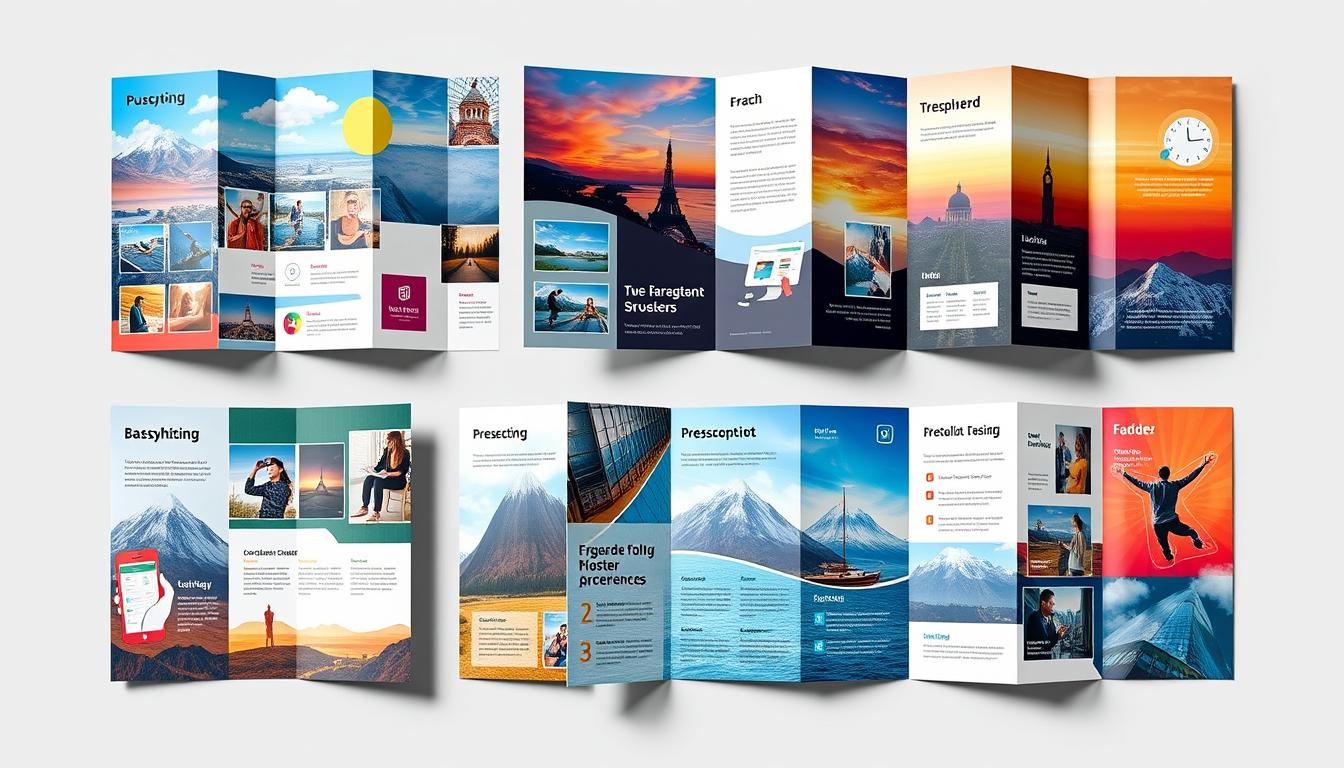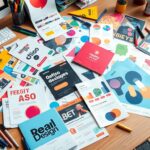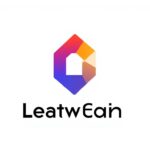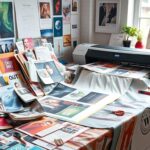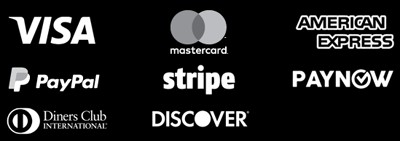In today’s digital world, physical marketing materials like brochures still hold their ground. They let businesses connect with customers in a real way. Brochures are great because they pack a lot of information into a small space.
The success of a brochure depends on many things. This includes the paper used and how it’s folded. Knowing about different papers helps make the brochure look good and work well. Matching the brochure’s look with its goals is important for success.
The fold is at the heart of a great brochure. It affects how the brochure looks and how well it grabs the audience’s attention. There are many folding styles, like tri-fold and gate-fold, that can make a brochure stand out.
Key Takeaways
- Brochures offer a tangible way for businesses to engage with their customers, allowing for physical interaction with the brand.
- The choice of paper stock, including matte vs. glossy and lightweight vs. heavyweight, significantly impacts the overall aesthetics and effectiveness of a brochure.
- The fold of a brochure is a critical element that can maximize impact and engagement with the audience, with various techniques like tri-fold, gate-fold, and booklet-style perfect-bound.
- Aligning the physical attributes of the brochure with the project’s objectives and desired visual impact is key to unlocking the true potential of print marketing.
- Exploring the versatility of brochure design and folding techniques can lead to attention-grabbing layouts that effectively convey the brand’s message and captivate the reader.
The Enduring Relevance of Brochures in the Digital Age
In today’s digital world, brochures still stand strong as a key marketing tool. They’ve evolved in size, design, and layout with the digital age. Yet, physical brochures remain a favorite for businesses of all sizes. In fact, up to 79% of small to medium-sized enterprises in the U.S.A. use brochures to share their brand’s identity and values.
Brochures as a Tangible Brand Statement
Brochures act as a real-life statement of a company’s brand. They show professionalism, mission, and what makes a brand unique through design. The feel of a brochure is unique and can’t be matched by digital ads, making them valuable in our virtual world.
The Transition to Digital and Its Impact
The move to digital brochures has changed their size, colors, and layout. But, physical brochures are still a top choice for businesses. Over 500 ambitious brands have worked with Superside, a leading design agency. Collabera’s 90-page brochure shows the lasting appeal of print marketing.
| Brand | Brochure Design Approach | Key Highlights |
|---|---|---|
| IKEA | Annual brochure presenting new product collection | Caters to home décor, fashion, and beauty brands |
| Disneyland | Digital brochure balancing imagery and text | Effective digital brochure design |
| Tiffany & Co. | Minimalist design with classic fonts and high-quality visuals | Conveys brand elegance and exclusivity |
| FujiFilm | Focus on product features and actual product images | Showcases innovative brand identity |
| Accenture | Bold colors, maxi typography, and contrasts | Highlights core brand values |
| Louis Vuitton | Elegant and striking design with brand icons and consistent color palette | Conveys luxury and exclusivity |
The catalogue market is expected to hit $335.62 billion by 2030. This shows the growing need for well-designed brochures. Businesses that invest in quality brochures often see big returns. Brochures are a cost-effective way to engage customers and boost sales.
Brochure Design Trends for 2024
Marketing is changing, and so is brochure design. In 2024, expect to see modern, minimalist designs. These will feature bold colors, striking typography, and beautiful images.
Minimalism is big in 2024 brochure design. Minimalist design is all about simplicity, focusing on the main message and visuals. Clean layouts and negative space add elegance and sophistication.
Typeface pairing is another trend. Pairing bold headlines with legible body fonts creates a balance. Serif and sans serif fonts together make for a striking design.
High-quality images are key in brochure design. Images help convey the message clearly, grabbing the audience’s attention. Brands use professional photos that match their identity and appeal to their audience.
Color schemes are also important. Blue is trusted, red is energetic, and green is natural, perfect for eco-friendly brands. Colors should match the brand and evoke the desired emotions.
Innovative design techniques are becoming more common. Techniques like embossing and foil stamping add luxury, while new folds and cuts make brochures more engaging.
In summary, 2024 brochure design trends focus on making a strong impression. Modern, minimalist designs with bold colors, typography, and images are key. By following these trends, businesses can enhance their branding and connect with their audience.
The Art of Paper Selection
Choosing the right paper is key to a great brochure. The mix of matte and glossy papers, along with the paper’s weight and thickness, greatly affects your brochure’s look and feel.
Matte vs. Glossy: The Aesthetic Dilemma
Matte paper gives a classy, subtle look. It’s perfect for brochures and business cards where you want to focus on the text. Glossy paper, on the other hand, makes colors pop. It’s great for eye-catching magazine covers and posters.
Weight Matters: Navigating Paper Thickness
The paper’s weight is crucial for your brochure’s quality. Light paper (74Lb and below) is good for flyers and everyday documents. Medium paper (80Lb-60Lb) is best for brochures and presentations, offering a mix of strength and flexibility. Heavy paper (100Lb and above) is best for durable items like business cards and high-quality prints.
Choosing the right paper is all about matching the paper’s features with your project’s goals and style. By picking the right paper, you can make a brochure that grabs attention and shows off your brand’s professionalism.
| Paper Type | Recommended Use | Key Characteristics |
|---|---|---|
| Lightweight Paper (74Lb and below) | Everyday printing needs like flyers and standard documents | Lightweight, economical, suitable for basic printing |
| Mediumweight Paper (80Lb-60Lb) | Brochures, presentations, and other marketing materials | Balanced sturdiness and flexibility, suitable for more dynamic projects |
| Heavyweight Paper (100Lb and above) | Business cards, postcards, and high-quality prints | Durable, luxurious feel, ideal for prestigious and long-lasting items |
Coated vs. Uncoated Paper: Understanding the Difference
Choosing between coated and uncoated paper for your brochure design is crucial. It affects the print quality and look of your brochure. Knowing the differences between these papers helps you pick the right one for your project.
Uncoated paper is natural and has a soft, warm look. It’s great for high-end prints because of its elegance. It’s also easy to write on, unlike coated paper.
Coated paper has a glossy finish and vibrant colors. It dries faster and is more durable. Your choice depends on what your project needs and the look you want.
| Characteristic | Uncoated Paper | Coated Paper |
|---|---|---|
| Surface Finish | Matte, porous, and absorbent | Smooth, glossy, and non-absorbent |
| Color Reproduction | Softer, warmer appearance | Vibrant and bold colors |
| Print Quality | Slightly lower than coated paper | Exceptional print quality |
| Drying Time | Longer drying time | Reduced drying time |
| Durability | Less durable than coated paper | More durable and resistant to damage |
| Writability | Easier to write on | More difficult to write on |
The choice between coated paper and uncoated paper depends on your project’s needs and desired look. Understanding each paper’s unique features helps you choose the best one. This choice will improve your brochure’s quality and impact.
Unlocking the Power of Brochures: Why the Fold Matters More Than You Think
In the world of print marketing, brochures are still a powerful tool. They can grab people’s attention and help businesses grow. The way a brochure is folded can make a big difference in how well it works.
A brochure with a well-thought-out fold can take the reader on a smooth journey. It shows important details without being too much. The feel of the paper, the colors, and the weight of the brochure make it special. This is something digital media can’t match.
Brochures are key in teaching people about products, services, or brands. They help build a brand’s identity and trust. Placing brochures in stores or at checkout can grab customers’ attention. Giving out brochures in welcome packets or member kits leaves a lasting impression, making new customers feel part of the community.
Adding digital touches like QR codes or website links in brochures can boost online engagement. This mix of physical and digital marketing creates a powerful experience.
Maximizing the Fold’s Potential
Brochures come in many folds, like trifold, half-fold, and z-fold. The fold you choose can change how the brochure looks and feels. It affects the design’s flow and impact.
- Trifold brochures guide the reader smoothly, with each part serving a purpose.
- Half-fold brochures are simple yet effective, perfect for short, impactful messages.
- Z-fold brochures offer an engaging experience, unfolding like a story.
Choosing the right fold and combining it with attention-grabbing design and engaging content can unlock a brochure’s full power. This can captivate audiences and lead to meaningful interactions.
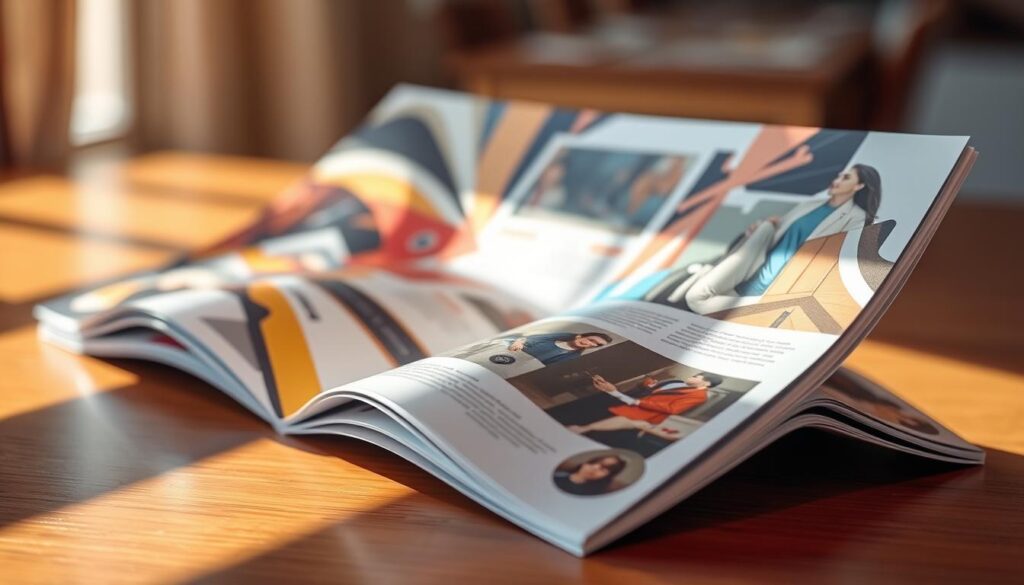
“The fold of a brochure is a critical element that can maximize impact and engagement with the audience.”
| Brochure Fold Type | Advantages | Recommended Use |
|---|---|---|
| Trifold | Natural progression for the reader, distinct purpose for each panel | Detailed product/service information, event promotion, company overviews |
| Half-fold | Simple yet effective layout, concise and impactful presentation | Quick reference guides, program schedules, product catalogs |
| Z-fold | Engaging experience, visual narrative through unfolding panels | Promotional campaigns, feature highlights, interactive brochures |
Captivating Your Audience with Stunning Visuals
Brochures are great for sharing important info with beautiful images and stories. They show off what your company offers in a way that grabs attention. Using top-notch photos makes your brochure stand out and leaves a strong impression.
The Power of Professional Photography
Professional photos are key to making brochures look amazing. They highlight your products or services and show off your brand’s personality. Spending on professional photos can really make your brochure memorable.
When picking images, think about a few things:
- Relevance: Make sure the pictures match your brochure’s message.
- Emotional Impact: Pick images that make people feel something, connecting with them.
- Consistency: Keep your visual style the same to show your brand’s unity.
With top-quality, professional photos, your brochure will grab people’s attention and make a lasting impression of your brand.
“Stunning visuals are the key to unlocking the true power of your brochure. They can make the difference between a forgettable handout and a memorable brand experience.”
The Fold: Maximizing Impact and Engagement
In the world of print marketing, the brochure fold is key to reader engagement. It guides your audience through a journey, showing important details clearly. With attention-grabbing layouts, you can make a strong impression that digital media can’t match.
Handling a brochure is a sensory experience that connects with your audience. The texture of the paper, the pictures, and the brochure’s weight all add to the experience. This makes your brand memorable and engaging.
Brochures are a cost-effective way to reach target audiences. They offer a memorable experience, helping your message stick. With smart brochure fold design, you can engage your audience and boost print marketing effectiveness.
| Brochure Marketing Benefits | Impact |
|---|---|
| Targeted Distribution | Enables businesses to reach specific audiences and increase the likelihood of generating qualified leads and conversions |
| Tangible Experience | Increases message retention and adds credibility to the brand |
| Cost-Effectiveness | Affordable printing and distribution methods make brochures a viable marketing option |
| Complementary to Digital | Brochures can drive traffic to online platforms through QR codes or website links |
Mastering brochure fold design creates a captivating experience for your audience. Unlock your print marketing’s full potential and leave a lasting impression. Make your readers want to learn more about your brand.
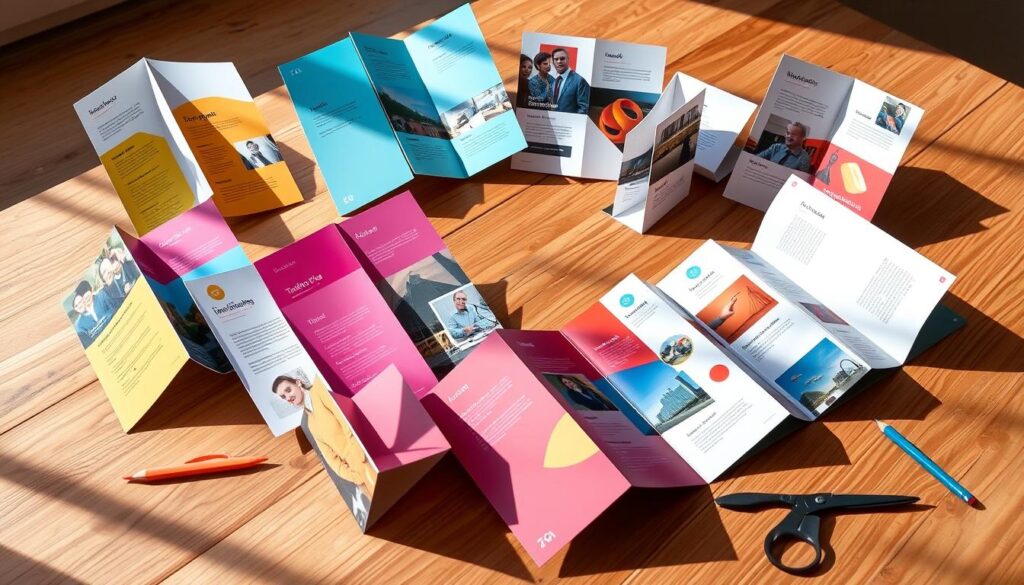
“Brochures remain a highly effective marketing tool in the digital age, offering a tangible and memorable experience that complements online efforts.”
Brand Storytelling Through Brochure Design
Brochures are a key way to show a company’s brand identity. They share values, mission, and professionalism through design. A good brochure can tell a brand’s story quickly, showing what makes it unique.
By matching the brochure design with the brand identity, companies make a strong print marketing tool. This tool speaks to the target audience in a meaningful way.
Conveying Your Brand’s Identity and Values
Brochures are more than marketing tools; they are a brand’s personality in print. They use typography, colors, and images to show the brand’s essence. This leaves a lasting impression on readers.
Brochure design for brand storytelling helps companies show their brand’s identity. It helps them stand out in the market.
Using brochure design lets companies share their brand values with their audience. It builds trust. A well-designed brochure can highlight a brand’s commitment to sustainability or show off its innovative products.
“A brochure is not just a marketing tool; it’s a tangible representation of your brand’s personality, values, and unique selling points.”
To make a brochure that connects with the audience, you need to know your brand and your customer. Aligning the brochure’s design, content, and distribution with your brand values creates a powerful marketing experience. It leaves a lasting impression on your audience.
Cost-Effective Marketing with High ROI
In today’s digital world, many think print marketing is outdated. But brochures are still a hit. Cost-effective print marketing through brochures can bring in great brochure ROI. They’re a smart choice for any print marketing strategy.
The U.S. direct mail industry is worth $44.2 billion. It’s the second-biggest ad spend channel. For every $167 spent, $2,095 is made, showing a 1,300% return. This shows brochures can be great for lead generation and brand awareness without breaking the bank.
Printing lots of brochures can save money. One brochure can be used in many ways, making it very valuable. They’re perfect for detailed info, like educational materials or product catalogs. You can also make them match your brand.
Brochures also feel good to touch, leaving a strong impression. They last longer than digital ads, staying on shelves for 17 days. This means more people see and interact with them, leading to better brochure ROI.
“Physical booklets have longevity, can be kept for future reference, and act as tangible reminders of a brand or message.”
Using brochures for marketing can bring big returns. They help businesses share what they offer and grow their brand.
The Tactile Experience: A Sensory Delight
In today’s world, where screens are everywhere, the value of touch in marketing is huge. A well-made brochure gives a unique, immersive experience that sticks with you. Holding and flipping through it engages your senses, from the paper’s feel to the images’ clarity.
Research finds that 78 percent of business leaders think physical items, like direct mail, boost branding. A brochure’s touch lets you connect with a brand in a way digital ads can’t. With the right paper and design, businesses can make a brochure that speaks to their audience and strengthens their brand.
The touch of a brochure does more than look good. Its weight and feel show quality and care. Finishes like spot UV coating or embossing add a special touch. Together, they make a customer experience that grabs your attention and leaves a strong brand impression.
“Creating moments of insight and connection in marketing efforts can transform engagement levels.”
By focusing on the touch in brochure design, businesses stand out. Mixing physical and digital marketing boosts impact. It delivers the message at the right time, increasing engagement and loyalty.
In a world where digital overload is common, a tactile brochure experience is a welcome change. It lets businesses create lasting connections and improve their brand impression with customers.
Brochure Design Examples from Industry Leaders
Leading brands and design firms have shown amazing brochure design inspiration. They’ve set new standards for print marketing best practices. Their work captures audiences and tells brand stories through branding through print design.
Pentagram, a famous design agency, made a sleek brochure for Bentley. It has bold colors, striking fonts, and top-notch visuals. This brochure matches Bentley’s luxury brand perfectly, making a big impact on its audience.
“A well-designed brochure can be a powerful tool for engaging and educating an audience.”
Landor, another creative agency, made a vibrant brochure for Microsoft. It uses bright colors, simple layouts, and eye-catching images. This brochure shows off Microsoft’s innovation and tech skills in a fun and engaging way.
These top brochures show how powerful print design can be today. By matching their designs with their brand identities, these companies have made lasting print marketing tools. These tools connect with their audiences and leave a strong impression.
Conclusion
In today’s fast-changing marketing world, brochures still play a big role. They are important even with all the digital tools around. By knowing how to design brochures well, using visuals, and understanding the fold, businesses can make the most of them. Brochures are a real way to show off a brand, giving people a feel and a lasting memory.
Top companies use brochures smartly to get great results and keep customers interested. They make brochures personal, eco-friendly, and fun to use. This shows how the brochure printing world keeps growing, giving businesses chances to make a big impact.
Brochures are great at telling a brand’s story and getting people involved. By following the best practices and trying new things, companies can use brochures to reach their goals. This way, they can get more than they expected from their marketing efforts.
FAQ
What is the importance of the fold in brochure design?
The fold of a brochure is key to its success. It can make a big impact and engage the audience. A well-designed brochure guides the reader through important details without feeling too much.
How have brochures adapted to the digital age?
Brochures have changed with the digital age. They now come in different sizes and designs. Yet, many still prefer physical brochures. In the U.S., up to 79% of small to medium-sized businesses use them.
What are the key brochure design trends for 2024?
For 2024, brochures will be modern and simple. They will use bold colors and big typography. The goal is to tell a brand’s story in a way that grabs attention and leaves a good impression.
What role does paper selection play in brochure success?
Choosing the right paper is crucial for a brochure. It affects how the brochure looks and feels. Knowing the differences in paper stocks helps make a brochure stand out.
How do coated and uncoated papers differ in their characteristics?
Uncoated paper is natural and elegant, perfect for luxury projects. Coated paper has a smooth finish and vibrant colors. It’s better for durability and quick drying.
How can brochures effectively tell a brand’s story?
Brochures show a company’s brand identity. They use colors, fonts, and images to share values and mission. A good brochure tells a brand’s story quickly and clearly.
What are the benefits of using brochures as a marketing tool?
Brochures are still a great marketing tool, even with digital options. They are affordable and powerful. A creative brochure can reach many people and bring in new customers.
How can the tactile experience of a brochure impact customer engagement?
Brochures offer a unique experience that digital ads can’t match. The feel and look of a brochure can make a lasting impression. It’s a hands-on way to engage with a brand.
Resources
Explore our curated list of recommended resources for printing, design, and free media assets. Whether you need professional printing services, free design templates, or royalty-free photos for your next project, these reliable sites have you covered.
Resources:
Explore our curated list of recommended resources for printing, design, and free media assets. Whether you need professional printing services, free design templates, or royalty-free photos for your next project, these reliable sites have you covered.1. Printing & Design
- Printing Inc. Description: Singapore-based online printing service offering a variety of print products such as business cards, flyers, brochures, and custom stickers with professional design services.
- Namecards Inc. Description: Specialist in name card printing, providing a wide range of custom designs, finishes, and materials for high-quality business cards.
- Kian Hong Press Description: Established corporate printing company in Singapore, offering solutions for brochures, catalogs, annual reports, and other corporate stationery.
2. Free Design Templates
- Canva Description: Offers a wide range of free and customizable templates for various needs, including presentations, posters, social media, and marketing materials.
- FreePik Description: Provides thousands of free and premium templates for brochures, flyers, business cards, and more, along with editable vector illustrations and graphics.
- Piktochart Description: Focused on data visualization and professional templates for infographics, posters, presentations, and reports, with both free and premium options.
3. Free Royalty-Free Photos
- Pexels Description: Offers high-quality, free stock photos and videos shared by talented creators for commercial and personal use without attribution.
- Unsplash Description: A large collection of beautiful, high-resolution images contributed by photographers worldwide, available for free use in any project.
- Pixabay Description: A community-driven platform offering copyright-free photos, illustrations, and videos for use in any creative project, with no licensing restrictions.

